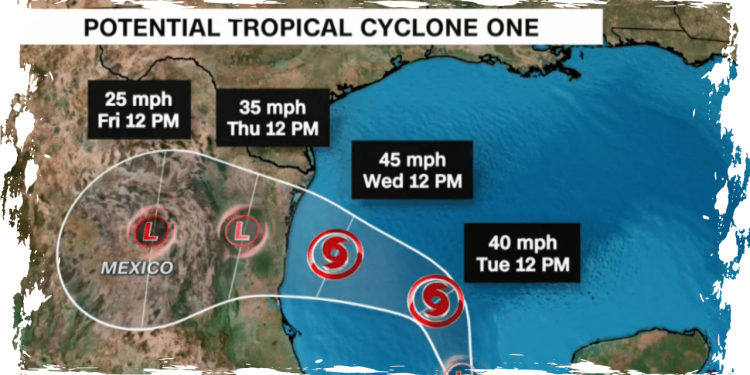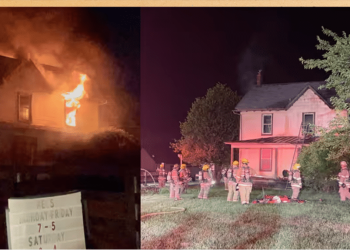Early Tuesday, the National Hurricane Center issued the initial tropical storm warning for this year’s hurricane season. Coastal communities in southern Texas are bracing for an imminent onslaught of heavy rainfall, flooding, and potentially tornadoes. The storm is currently forming over the southern Gulf of Mexico and is expected to make landfall as a potential tropical cyclone.
It is highly likely that the storm will be named the first of the season, Tropical Storm Alberto, if it strengthens enough. According to forecasters on Tuesday, there is an 80% chance of it developing into a tropical storm within the next 48 hours.
Coastal areas of Texas from Port O’Connor to the mouth of the Rio Grande and the Gulf Coast of Mexico are under a tropical storm warning. Additionally, widespread rainfall associated with the possible tropical cyclone is predicted to impact significant portions of Central America.
The National Hurricane Center’s map revealed that the storm system was set to hit coastal regions just after midnight on Thursday. However, meteorologists were quick to point out that the effects of the storm would be felt on land much sooner than that. According to the latest forecasts, the system had already reached maximum sustained winds of around 40 miles per hour, and it was expected to gain even more strength over the next 36 hours. As a result, heavy rainfall and coastal flooding were anticipated to occur within the next day or two.
According to a Tuesday advisory from the hurricane center, the disturbance is expected to cause significant coastal flooding, rainfall, and wind impacts along the coasts of Texas and northeastern Mexico. Meteorologists have also stated that tropical storm force winds are extending up to 415 miles outward from the core of the disturbance, which is still considered “large but disorganized” and hovering over the western Gulf as of 1 p.m. It is important to stay updated on the situation and take necessary precautions to stay safe during this time.
The hurricane center in Texas has issued a warning stating that moderate coastal flooding is expected to hit the region from Tuesday and continue through the middle of the week. As per the forecast, the situation is likely to worsen on Wednesday for people living in the tropical storm warning area. They may experience flash flooding and flooding in urban areas due to overflowing rivers. Additionally, mudslides are also expected in northeastern Mexico.
At 4 a.m. CT on Tuesday, the National Hurricane Center raised the current season’s first tropical storm watch to a tropical storm warning. Following suit, the government of Mexico replaced the previous tropical storm watch with a tropical storm warning for the northeastern coast’s parts, south of the Rio Grande’s mouth to Puerto de Altamira. The difference between the two is the timing. Typically, forecasters issue a “watch” when tropical storm conditions are possible in the impacted area within 48 hours, while a “warning” is issued when the conditions become more imminent, which is about 36 hours out.
On Tuesday morning, the hurricane center reported that the possible storm was heading north over the Gulf and was expected to make a turn towards the west and west-northwest overnight and into Wednesday before reaching the western Gulf on Wednesday night. According to the forecasters, northeastern Mexico and southern Texas could experience rainfall ranging from 5 to 10 inches. However, it is possible that some areas could experience more severe flooding.
According to the 7 a.m. CT advisory issued by the hurricane center on Tuesday, the surge of the perilous storm and the tide will lead to the flooding of typically dry areas near the coast by the rising waters moving inland from the shoreline.
The forecast for the potential storm indicates that if the peak storm surge coincides with high tide, flooding in certain areas along the Gulf Coast in Texas and Mexico could rise up to 4 feet above ground. The hurricane center predicts that the areas closest to the potential landfall location and those located north of it will experience the deepest water levels due to the combined effect of the storm surge and large, dangerous waves. Additionally, the swells from the storm are expected to create hazardous surf conditions and rip currents that could pose a threat to human life.
The Atlantic hurricane season, which lasts from June 1 to November, is now in full swing. Although most of the storm activity usually occurs between mid-August and mid-October, people should remain vigilant during the entire season. Meteorologists use the terms hurricane and tropical cyclone interchangeably to refer to the same type of storm. The National Oceanic and Atmospheric Administration explains that tropical cyclone is a broad classification that encompasses any weather phenomenon where rotating, low-level cloud systems and thunderstorms develop over tropical or subtropical waters.
Once a tropical cyclone’s maximum wind speeds surpass 39 mph, it is classified as a tropical storm. As soon as the sustained winds hit 74 mph or higher, it is elevated to the status of a hurricane.










